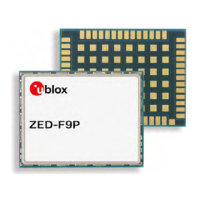
Do you have a question about the Ublox ZED-F9P and is the answer not in the manual?
| GNSS Support | GPS, GLONASS, Galileo, BeiDou, QZSS, SBAS |
|---|---|
| Channels | 184 |
| Positioning Accuracy (RTK) | 1 cm + 1 ppm |
| Update Rate | Up to 20 Hz |
| Time Accuracy | 30 ns |
| Power Supply | 2.7 V to 3.6 V |
| Operating Temperature | -40 °C to +85 °C |
| Horizontal Accuracy | 2.5 m |
| Interfaces | UART, USB, SPI, I2C |
| Dimensions | 22 x 17 x 2.4 mm |
| Frequency Bands | L1, L2, L5 |
Summary of the document's content, features, and accuracy of the ZED-F9P module.
Explains the ZED-F9P's precision capabilities and its next-level GNSS precision.
Details the two operational modes for the ZED-F9P: as a base station or as a rover.
Illustrates common application scenarios for the ZED-F9P, such as drone and robotic mower.
Specifies the default configuration settings for GNSS reception by the ZED-F9P module.
Discusses the necessity of RTCM3 corrections for RTK operation and lists supported input/output messages.
Provides a detailed list of RTCM3 messages supported for input by the ZED-F9P.
Lists the RTCM3 messages that the ZED-F9P can output when configured as a base station.
Explains the NTRIP protocol for streaming RTCM correction data over the internet.
Describes the VRS concept for achieving centimeter-level accuracy using a network of reference stations.
Details methods and messages for configuring the ZED-F9P module's settings.
Mentions legacy UBX-CFG messages are deprecated but still accepted in early beta firmware.
Presents a high-level block diagram of the ZED-F9P module, showing key functional blocks.
Details how to connect the main and backup power supplies to the ZED-F9P module.
Lists and describes the various interfaces available on the ZED-F9P module.
Emphasizes the sensitive nature of the ZED-F9P and precautions for handling to prevent damage.
Outlines specific measures to protect against ESD during handling and production.
Discusses Electrical Overstress (EOS) and recommended protection measures, especially with wireless transceivers.
Details safety requirements including external limited power source and SELV circuits.
Explains the susceptibility of GNSS receivers to interference due to low signal power.
Lists methods to mitigate in-band interference, such as grounding, shielding, and filtering.
Describes out-of-band interference sources and mitigation strategies, including band-pass filters.
Shows the pin assignment of the ZED-F9P module and lists the defined PIO configurations.
Discusses options for RF front-end circuits, including separate and combined GNSS/L-Band systems.
Details layout and placement requirements for the ZED-F9P receiver on a PCB.
Presents layout guidance to minimize performance issues at the design level.
Provides detailed guidelines for soldering the ZED-F9P, including paste recommendations and reflow profiles.
Illustrates the feed direction and orientation of ZED-F9P modules on the tape for automated assembly.
Specifies the reel quantities and type for shipping ZED-F9P modules.
Details the Moisture Sensitivity Level (MSL) for ZED-F9P high precision receivers.
Describes the typical stacked patch antenna design and its characteristics for L1+L2 reception.